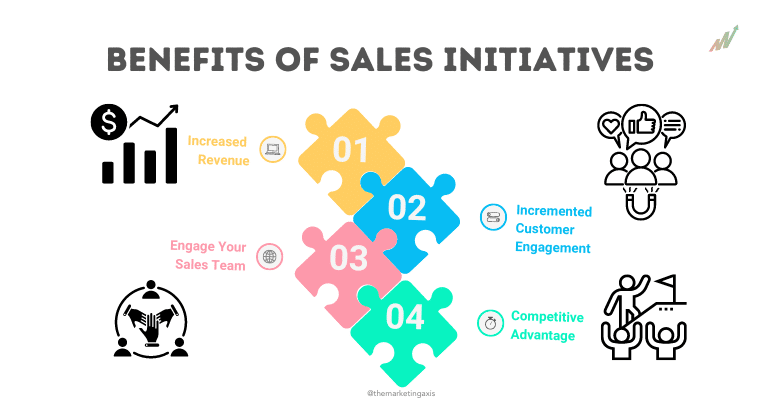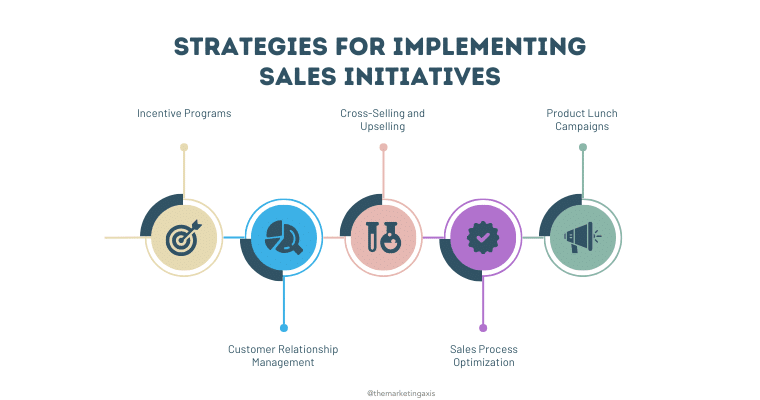Today’s market is highly competitive, and it needs more than just the ordinary techniques of selling to be out front. Companies must continue innovating and creating sales initiatives to drive growth and improve performance. Sales initiatives that are well-planned will have the effect of re-energizing your sales team, firming up your relationships with your customer base, and having a monumental impact on your bottom line. This article explains what a sales initiative is, its benefits, and how to effectively execute.
What is a Sales Initiative?
A sales initiative is therefore an action or plan that aims to increase sales performance to satisfy the set-out goals of the business. This can range from introducing new products to the market, new market entries, improving upon the process of making sales, and adopting newer technologies meant to help in the execution of the task. The main aim of such types of initiatives is to carry out sales growth and ensure customer engagement while taking into consideration the competitive advantage that is attained.
Benefits of Sales Initiatives

- Increased Revenue: Effective sales initiatives thus gain directly from increased sales and revenues. It can help a business to exploit newer markets or reach out to customer segments by focusing on targeted strategies.
- Incremented Customer Engagement: The majority of the sales initiatives incorporate personalized approaches and new-age solutions that increase customer satisfaction and brand loyalty.
- Engage Your Sales Team: Bring new initiatives to life and give your sales team new energy. Fill them with the drive they need to reach new targets and increase your bottom line.
- Competitive Advantage: Understanding the trends in the industry and continually making improvements to the sales strategies can help the business leverage a strong competitive advantage over the competitors.
Key Components of a Successful Sales Initiative
- Clear objectives: The specific, measurable, attainable, relevant, and time-bound goals should be clearly stated about the sales initiative.
- Market research: Market research entails extensive research to understand market trends, customer needs, and strategies of competitors.
- Target Audience: Identify the target audience and segment them to take appropriate sales behavior. The target audience can be identified and segmented to tailor one’s selling system.
- Sales Training: On offer of continuous training and development programs empowers the sales team to gain skills and knowledge that equate to performance improvement in subjects such as communication, customers, and products or services.
- Technology Integration: Automation with the help of sales, CRM, and analytics to execute processes seamlessly and derive insights.
- Monitoring and Evaluation: Regular re-assessment of the outcomes on sales ensures that you are on course—no course correction is needed.
Strategies for Implementing Sales Initiatives

- Product Launch Campaigns: Introduce new products into the market with compelling campaigns that mark out special features of the product and what benefits it holds for a customer. Reach out to potential customers through social media, email marketing, and live demos.
- Cross-Selling and Upselling: Allow members of your sales team the skills to cross-sell and upsell existing customers. This raises the level of sales while building stronger bonds in the buyer-relations process.
- Incentive Programs: Motivate the sales force more with additional incentive programs where they are rewarded even more for their great performance. This can be in the form of a cash bonus, commission, a pat on the back, or even non-monetary rewards in the form of career opportunities.
- Customer Relationship Management: Invent an effective CRM system that will help manage contact with customers, track the activities of sales, and analyze the data for decision-making.
- Sales Process Optimization: Continually review and improve your sales process so that inefficiencies can be rooted out and every avenue taken to improve effectiveness. This can be in line with the adoption of emerging technologies, reduction of workflow, or better communication processes.
Real-Life Examples of Successful Sales Initiatives
- Hubspot Inbound Marketing:
HubSpot changed the face of marketing by introducing inbound marketing. It is through the valuable content provided and the cultivation of its leads that HubSpot acquires loyal customers around its sales initiative.
- Apple Product Launch:
Apple has a good amount of planning in terms of the product launch event. They create a huge amount of buzz and anticipation for any new device. Their commitment to sales includes a strong focus on the innovation of the product, marketing activities, and customer experience.
- Customer-Centric Sales at Salesforce:
The philosophy of Salesforce sales revolves around customer-centricity. Their secured CRM platform and customized sales strategies have brought huge growth and customer retentiveness.
Challenges in Implementing Sales Initiatives
- Resistance to Change: The sales team members may resist new initiatives, particularly those predisposed to bring much change to the manner of sale they have perceived so far.
- Resource Allocation: Implementing an initiative in sales will most likely require a great deal of investment in terms of time, money, and human resources.
- Measuring Success: Any measure for a sales initiative has been somewhat hard. The key to being able to communicate these things is through the establishment of clear metrics and then the continuous measuring of the performance based on these metrics.
Conclusion
Sales initiatives is one of the important parts of business development and ensuring competitiveness in a fast-moving market. Your plans can ensure sustainable growth by defining clear objectives, doing thorough research, and continuously improving your strategies for greater sales performance. Concentrate on the fact of innovation by empowering your selling team to be more productive and knowledgeable by delivering better customer experiences.
References
- Armstrong, G., Kotler, P., Harker, M. and Brennan, R. (2018) Marketing: An Introduction. 13th ed. Harlow: Pearson.
- Brown, A. (2019) Customer Engagement Strategies. New York: McGraw-Hill.
- Buttle, F. (2009) Customer Relationship Management: Concepts and Technologies. 2nd ed. Oxford: Butterworth-Heinemann.
- Buttle, F. and Maklan, S. (2019) Customer Relationship Management: Concepts and Technologies. 4th ed. London: Routledge.
- Cross, R. (2013) Upselling and Cross-Selling Strategies. Boston: Harvard Business Press.
- Doran, G.T. (1981) ‘There’s a S.M.A.R.T. way to write management’s goals and objectives’, Management Review, 70(11), pp. 35-36.
- Honeycutt, E.D., Ford, J.B. and Simintiras, A.C. (2003) Sales Management: A Global Perspective. London: Routledge.
- Johnson, M. (2021) Strategic Sales Initiatives. New York: Business Expert Press.
- Kaplan, R.S. and Norton, D.P. (1996) The Balanced Scorecard: Translating Strategy into Action. Boston: Harvard Business School Press.
- Kotler, P. and Armstrong, G. (2018) Principles of Marketing. 17th ed. Harlow: Pearson.
- Kotler, P. and Keller, K.L. (2016) Marketing Management. 15th ed. Harlow: Pearson.
- Williams, K. (2020) Innovative Sales Strategies. San Francisco: Jossey-Bass.
Only having a sales Knowledge is not enough to compete a real-world. So here are some of the Marketing Strategies that will surely help you in coming days.
Frequently Asked Questions (FAQ’s)
1. What is a sales initiative?
In the broad sense, a sales initiative is any strategic plan or campaign that is undertaken to improve sales and the engaged customer base. New marketing campaigns, the introduction of new products, sales training programs, and changes in sales tactics-processes are all directed at specific business-oriented goals.
2. How do you prioritize sales initiatives?
The priorities in sales initiatives would have to be done based on where every potential initiative stands missions, possible return on investment, results on key performance indicators, and the value expected to be created for stakeholders. Therefore, it becomes very important to concentrate on initiatives that have the highest strategic value and are closely aligned with the goals laid down by the organization.
3. What are the key components of a successful sales initiative?
A good sales initiative embodies the following factors: well-defined objectives, pinpointed target audience, robust executable plan, monitoring and evaluation, and proper structures of communication. Besides, it extracts insights from data analytics and customer insights to assist in tailoring initiatives to customer needs and demands.
4. How can technology support sales initiatives?
The role of technology in bettering sales efforts comes into reality through tools cited in customer relationship management, data analysis, and communication. HubSpot CRM, Zoom, and LinkedIn Sales Navigator are just a few tools that help to ease out sales processes, enrich customer engagement, and provide actionable insights that can improve the effectiveness of sales initiatives.
5. What are common challenges in implementing sales initiatives?
Common challenges include the intrinsic aversion of the sales team to change, lack of resources and training, a misfit in the overall strategy of the business, and measuring the success of the initiatives. Then, customers can overcome these obstacles on their own by having strong leadership, communication, and ongoing help and learning within the sales team.


